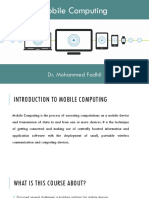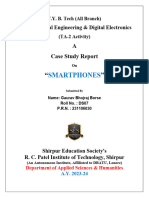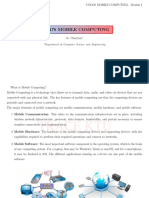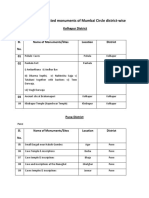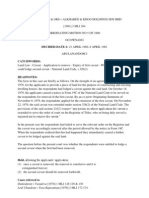CHARACTERISTICS OF MOBILE COMPUTING
1. Portability - The Ability to move a device within a learning environment or to
different environments with ease.
2. Social Interactivity - The ability to share data and collaboration between users.
3. Context Sensitivity - The ability to gather and respond to real or simulated data unique
to a current location, environment, or time.
4. Connectivity - The ability to be digitally connected for the purpose of communication
of data in any environment.
5. Individual - The ability to use the technology to provide scaffolding on difficult
activities and lesson customization for individual learners.
6. Small Size - Mobile devices are also known as handhelds, palmtops and smartphones
due to their roughly phone-like dimensions. A typical mobile device will fit in the
average adult's hand or pocket. Some mobile devices may fold or slide from a compact,
portable mode to a slightly larger size, revealing built-in keyboards or larger screens.
ISSUES OF MOBILE COMPUTING
Battery Life: Mobile devices are limited by their battery life. The demand for more powerful
hardware and increased functionality often conflicts with the need for longer battery life.
Manufacturers and software developers continually seek to optimize power consumption to
extend battery life.
1. Security Concerns: Mobile devices are susceptible to various security threats,
including malware, phishing, and data breaches. With the increasing reliance on
mobile devices for personal and business tasks, security measures such as encryption,
biometric authentication, and secure software updates are essential.
2. Privacy: Mobile devices often collect and store sensitive personal information.
Privacy concerns arise regarding how this data is used, shared, and protected.
Regulatory frameworks like GDPR (General Data Protection Regulation) in Europe
aim to safeguard user privacy and regulate data handling practices.
3. Network Connectivity: Mobile devices rely on network connectivity, which can be
unreliable or unavailable in certain areas. Issues such as network congestion, signal
interference, and coverage gaps affect the user experience. Technologies like 5G aim
to improve network speed, reliability, and coverage.
4. Compatibility and Fragmentation: The diversity of mobile devices, operating
systems (e.g., iOS, Android), and versions thereof, along with the myriad of
applications available, can lead to compatibility issues and fragmentation. Developers
must ensure their apps function correctly across various platforms and device
configurations.
5. User Interface and Experience: Designing intuitive and user-friendly interfaces for
mobile devices presents unique challenges due to limited screen real estate and
� varying input methods (touch, gestures, voice). Ensuring a consistent and seamless
user experience across different devices and screen sizes is crucial.
6. Data Synchronization: Mobile users often switch between multiple devices (e.g.,
smartphones, tablets, laptops), necessitating seamless data synchronization across
these devices. Issues may arise regarding synchronization conflicts, data loss, and
bandwidth constraints.
7. Mobile Payment Security: With the increasing adoption of mobile payment
methods, security concerns regarding financial transactions conducted via mobile
devices have become paramount. Secure authentication methods, encryption, and
adherence to payment industry standards (e.g., PCI DSS) are essential for ensuring
payment security.
8. Device Management and BYOD: Bring Your Own Device (BYOD) policies present
challenges for organizations in terms of managing and securing a diverse array of
employee-owned devices accessing corporate networks and data. Mobile Device
Management (MDM) solutions help enforce security policies and manage mobile
devices centrally.
9. Digital Divide: Disparities in access to mobile technology and internet connectivity
contribute to the digital divide, limiting opportunities for individuals and
communities. Efforts to bridge this gap include initiatives to provide affordable
devices, improve infrastructure, and increase digital literacy.

























